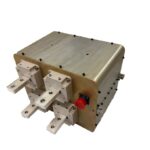Image: Charles de Gheldere, IATA director digital and data. Courtesy: IATA
Charles de Gheldere, IATA director digital and data, tells FINN how IATA’s ‘turbulence aware’ platform is delivering safer flight.
Experiencing turbulence on an aircraft can be stressful, particularly for anxious passengers, and the challenge of managing turbulence is expected to grow as climate change continues to impact weather patterns. This has implications for both safety and efficiency of flight.
In 2018 IATA launched “turbulence aware”, a platform which helps airlines mitigate the impact of turbulence, which is a leading cause of passenger and crew injuries and higher fuel costs each year.
Charles de Gheldere, IATA director digital and data, said: “The platform pools anonymised turbulence data from thousands of flights operated by participating airlines. The real-time accurate information enables pilots and dispatchers to choose optimal flight paths, avoiding turbulence and flying at optimum levels to maximise fuel efficiency and thereby reduce CO2 carbon emissions.”
The software, developed by the National Centre of Atmospheric Research (NCAR), is installed in the avionics system of the aircraft – some of the newer type of aircraft, such as the Airbus A350, Boeing 737 MAX and Boeing 787 come with this software pre-installed. Airlines also have the option of an in-house implementation – as long as they have the technical capability.
IATA said it is also speaking to other OEMs, including Embraer, about getting involved in the programme.
De Gheldere said the platform is easy to use: “An aircraft will be able to generate smooth air reports every 15 to 30 minutes in case of areas with nil turbulence, and, once a certain intensity threshold is crossed, the frequency of the reports will increase to one per minute,” he said.
“Turbulence aware receives the existing airline data from the airlines’ ground servers, performs quality control, deidentifies data, and provides the data back to airlines via a ground-to-ground, system-to-system connection.”
Airlines with inflight connectivity display the turbulence reports in real time through an integrated weather tool running on their electronic flight bags (EFB).
The turbulence aware integration with the EFBs eliminates the need for additional screens in the cockpit and in the operational control centre. Airlines without connectivity will have their dispatchers send aircraft communications addressing and reporting system (ACARS) messages to pilots warning them about near turbulence.
Web-based application
Both pilots and dispatchers have access to the IATA turbulence aware MET viewer, an IATA web-based application which can be accessed from a tablet, a laptop and even a phone with a larger screen.
De Gheldere said: “With access to real-time turbulence data through turbulence aware, pilots, dispatchers and cabin crew can now know where turbulence is exactly located, and this information can help them take better operational decisions.
“There is a very good coverage over areas such as North America, Europe, and the Middle East.”
Currently more than 1,900 individual aircraft from 21 different airlines are taking part in the programme, including Swiss, United, easyJet, Qatar Airways and Saudia. It’s not just commercial aircraft, but also business jet operators. The more contributors we have, the more everyone benefits. At the end of the day, safety is number one. We want to make sure that everybody is safe in the sky, and indeed on the ground.
“Also, the fuel consumption and the fuel optimisation is another factor for airlines to take into consideration, as well as maintenance of an aircraft. “From an airline’s perspective, the less turbulence an aircraft is going through, the less time it has to stay in maintenance, which automatically means that you’re spending money to keep the aircraft grounded. Ideally, we would like to get to the point where any airline can have the solution available for their type of aircraft,” de Gheldere concluded.

